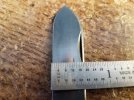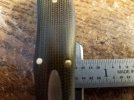I sit firmly in the camp where a knife should be able to be closed by its own spring force unhindered without the edge bouncing against the backspring.
That said, some of my knives I now try to remember to close softly rather than be stubborn.
I have filed a kick or two in my day, because you shouldn't be able to catch your finger on the tip of a closed knife.
Just because the blade can be pushed down when fully closed doesn't mean it can't have blade rap. Blade rap is not from the edge setting on the spring, it's from the blade over traveling when closing and bouncing down to hit the spring. It is also not always at the spring pin, it can often be at the belly or near the tip.
I think there are a lot of things that factor into whether a knife has blade rap: blade tallness, blade length, blade shape, blade well / spring shape, and yes spring strength. I do think it makes sense that both a very weak spring (almost or doesn't close by its own spring force) or a very strong spring (doesn't allow for over travel when closing) are less likely to have blade rap.
P.s. I've seen Bill close knives both softly and by full spring force.
That said, some of my knives I now try to remember to close softly rather than be stubborn.
I have filed a kick or two in my day, because you shouldn't be able to catch your finger on the tip of a closed knife.
Just because the blade can be pushed down when fully closed doesn't mean it can't have blade rap. Blade rap is not from the edge setting on the spring, it's from the blade over traveling when closing and bouncing down to hit the spring. It is also not always at the spring pin, it can often be at the belly or near the tip.
I think there are a lot of things that factor into whether a knife has blade rap: blade tallness, blade length, blade shape, blade well / spring shape, and yes spring strength. I do think it makes sense that both a very weak spring (almost or doesn't close by its own spring force) or a very strong spring (doesn't allow for over travel when closing) are less likely to have blade rap.
P.s. I've seen Bill close knives both softly and by full spring force.






